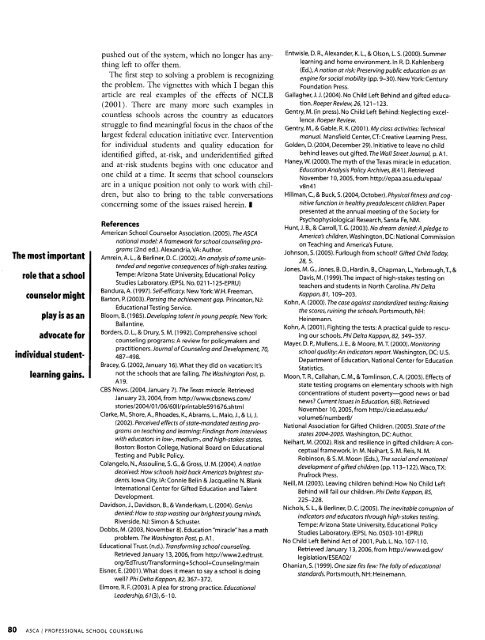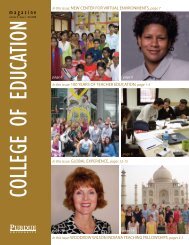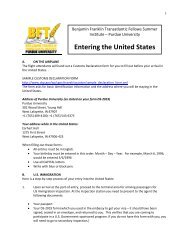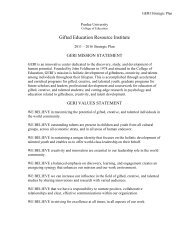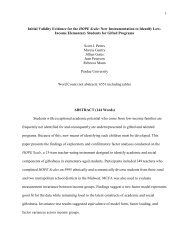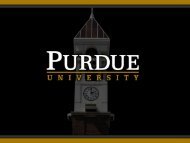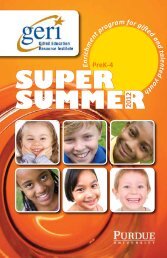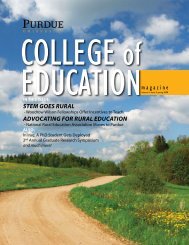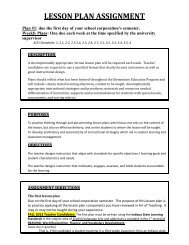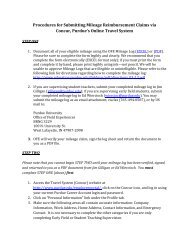No child left behind: Gifted children and school counselors.
No child left behind: Gifted children and school counselors.
No child left behind: Gifted children and school counselors.
You also want an ePaper? Increase the reach of your titles
YUMPU automatically turns print PDFs into web optimized ePapers that Google loves.
The most importantrole that a <strong>school</strong>counselor mightplay is as anadvocate forindividual studentlearninggains.pushed out of the system, which no longer has anything<strong>left</strong> to offer them.The first step to solving a problem is recognizingthe problem. The vignettes with which I began thisarticle are real examples of the effects of NCLB(2001). There are many more such examples incountless <strong>school</strong>s across the country as educatorsstruggle to find meaningful focus in the chaos of thelargest federal education initiative ever. Interventionfor individual students <strong>and</strong> quality education foridentified gifted, at-risk, <strong>and</strong> underidentified gifted<strong>and</strong> at-risk students begins with one educator <strong>and</strong>one <strong>child</strong> at a time. It seems that <strong>school</strong> <strong>counselors</strong>are in a unique position not only to work with <strong>child</strong>ren,but also to bring to the table conversationsconcerning some of the issues raised herein. IReferencesAmerican School Counselor Association. (2005). TheASCAnational model: A framework for <strong>school</strong> counseling programs(2nd ed.). Alex<strong>and</strong>ria, VA: Author.Amrein, A. L., & Berliner, D. C. (2002). An analysis of some unintended<strong>and</strong> negative consequences of high-stakes testing.Tempe: Arizona State University, Educational PolicyStudies Laboratory. (EPSL <strong>No</strong>. 0211-125-EPRU)B<strong>and</strong>ura, A. (1997). Self-efficacy. New York: W.H. Freeman.Barton, P. (2003). Parsing the achievement gap. Princeton, NJ:Educational Testing Service.Bloom, B. (1985). Developing talent in young people. New York:Ballantine.Borders, D. L., & Drury, S. M. (1992). Comprehensive <strong>school</strong>counseling programs: A review for policymakers <strong>and</strong>practitioners. Journal of Counseling <strong>and</strong> Development, 70,487-498.Bracey, G. (2002, January 16). What they did on vacation: It'snot the <strong>school</strong>s that are failing. The Washington Post, p.A19.CBS News. (2004, January 7). The Texas miracle. RetrievedJanuary 23, 2004, from http://www.cbsnews.com/stories/2004/01/06/6011/printable591676.shtmlClarke, M., Shore, A., Rhoades, K., Abrams, L., Maio, J., & Li, J.(2002). Perceived effects of state-m<strong>and</strong>ated testing programson teaching <strong>and</strong> learning: Findings from interviewswith educators in low-, medium-, <strong>and</strong> high-stakes states.Boston: Boston College, National Board on EducationalTesting <strong>and</strong> Public Policy.Colangelo, N., Assouline, S. G., & Gross, U. M. (2004).A nationdeceived: How <strong>school</strong>s hold back America's brightest students.Iowa City, IA: Connie Belin & Jacqueline N. BlankInternational Center for <strong>Gifted</strong> Education <strong>and</strong> TalentDevelopment.Davidson, J., Davidson, B., & V<strong>and</strong>erkam, L. (2004). Geniusdenied: How to stop wasting our brightest young minds.Riverside, NJ: Simon & Schuster.Dobbs, M. (2003, <strong>No</strong>vember 8). Education "miracle" has a mathproblem. The Washington Post, p. Al.Educational Trust. (n.d.). Transforming <strong>school</strong> counseling.Retrieved January 13,2006, from http://www2.edtrust.org/EdTrust/Transforming+School+Counseling/mainEisner, E. (2001).What does it mean to say a <strong>school</strong> is doingwell? Phi Delta Kappan, 82,367-372.Elmore, R. F. (2003). A plea for strong practice. EducationalLeadership, 61(3), 6-10.Entwisle, D. R., Alex<strong>and</strong>er, K. L., & Olson, L. S. (2000). Summerlearning <strong>and</strong> home environment. In R. D. Kahlenberg(Ed.), A notion at risk: Preserving public education as anengine for social mobility (pp. 9-30). New York: CenturyFoundation Press.Gallagher, J.J. (2004). <strong>No</strong> Child Left Behind <strong>and</strong> gifted education.Roeper Review, 26,121-123.Gentry, M. (in press). <strong>No</strong> Child Left Behind: Neglecting excellence.Roeper Review.Gentry, M., & Gable, R. K. (2001). My class activities: Technicalmanual. Mansfield Center, CT: Creative Learning Press.Golden, D. (2004, December 29). Initiative to leave no <strong>child</strong><strong>behind</strong> leaves out gifted. The Wall Street Journal, p. Al.Haney, W. (2000).The myth of the Texas miracle in education.Education Analysis Policy Archives, 8(41). Retrieved<strong>No</strong>vember 10, 2005, from http://epaa.asu.edu/epaa/v8n41Hillman, C., & Buck, S. (2004, October). Physical fitness <strong>and</strong> cognitivefunction in healthy preadolescent <strong>child</strong>ren. Paperpresented at the annual meeting of the Society forPsychophysiological Research, Santa Fe, NM.Hunt, J. B., & Carroll, T. G. (2003). <strong>No</strong> dream denied:A pledge toAmerica's <strong>child</strong>ren. Washington, DC: National Commissionon Teaching <strong>and</strong> America's Future.Johnson, S. (2005). Furlough from <strong>school</strong>? <strong>Gifted</strong> Child Today,28, 5.Jones, M. G., Jones, B. D., Hardin, B., Chapman, L., Yarbrough, T., &Davis, M. (1 999).The impact of high-stakes testing onteachers <strong>and</strong> students in <strong>No</strong>rth Carolina. Phi DeltaKappan, 81, 109-203.Kohn, A. (2000). The case against st<strong>and</strong>ardized testing: Raisingthe scores, ruining the <strong>school</strong>s. Portsmouth, NH:Heinemann.Kohn, A. (2001). Fighting the tests: A practical guide to rescuingour <strong>school</strong>s. Phi Delta Kappan, 82, 349-357.Mayer, D. R, Mullens, J. E., & Moore, M.T. (2000). Monitoring<strong>school</strong> quality:An indicators report. Washington, DC: U.S.Department of Education, National Center for EducationStatistics.MoonT. R., Callahan, C. M., & Tomlinson, C. A. (2003). Effects ofstate testing programs on elementary <strong>school</strong>s with highconcentrations of student poverty-good news or badnews? Current Issues in Education, 6(8). Retrieved<strong>No</strong>vember 10, 2005, from http://cie.ed.asu.edu/volume6/number8/National Association for <strong>Gifted</strong> Children. (2005). State of thestates 2004-2005. Washington, DC: Author.Neihart, M. (2002). Risk <strong>and</strong> resilience in gifted <strong>child</strong>ren: A conceptualframework. In M. Neihart, S. M. Reis, N. M.Robinson, & S. M. Moon (Eds.), The social <strong>and</strong> emotionaldevelopment of gifted <strong>child</strong>ren (pp. 113-122). Waco, TX:Prufrock Press.Neill, M. (2003). Leaving <strong>child</strong>ren <strong>behind</strong>: How <strong>No</strong> Child LeftBehind will fail our <strong>child</strong>ren. Phi Delta Kappan, 85,225-228.Nichols, S. L., & Berliner, D. C. (2005). The inevitable corruption ofindicators <strong>and</strong> educators through high-stakes testing.Tempe: Arizona State University, Educational PolicyStudies Laboratory. (EPSL <strong>No</strong>. 0503-101 -EPRU)<strong>No</strong> Child Left Behind Act of 2001, Pub. L. <strong>No</strong>. 107-110.Retrieved January 13,2006, from http://www.ed.gov/legislation/ESEA02/Ohanian, S. (1999). One size fits few: The folly of educationalst<strong>and</strong>ards. Portsmouth, NH: Heinemann.80 ASCA I PROFESSIONAL SCHOOL COUNSELING


